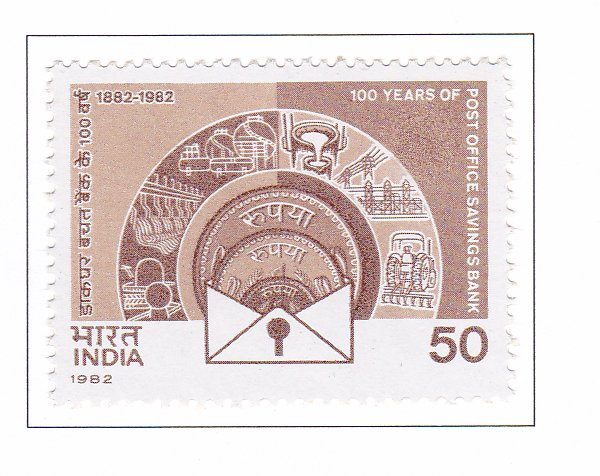Centenary of Post Office Savings Bank

Technical Data
| Date of Issue | October 23, 1982 |
|---|---|
| Denomination | 50 p |
| Quantity | 2,000,000 |
| Perforation | comb 13¼ x 13 |
| Printer | Security Printing Press, Nashik |
| Watermark | No Watermark |
| Colors | Multicolor |
| Catalog Codes |
Michel IN 921 Stamp Number IN 992 Yvert et Tellier IN 732 Stanley Gibbons IN 1056 |
| Themes | Anniversaries and Jubilees | Banks | Coins |
The establishment of the Post Office Savings Bank on April 1, 1882, marked a significant milestone in the history of popular banking in India. Authorized by the Government Savings Bank Act of 1873, this initiative aimed to provide accessible banking services to the general public. Prior to this, government banking existed in limited capacities in the form of Government Savings Banks in the Presidency towns of Calcutta, Madras, and Bombay, as well as District Savings Banks at district headquarters.
The introduction of the Post Office as a banking entity led to a significant expansion in the number of banks, accounts, and deposits. In its first year alone, there were 4046 Post Office banks, with 39,000 accounts holding deposits amounting to Rs. 28 lakhs. This success eventually led to the merger of District Savings Banks into the Post Office Savings Bank on April 1, 1886, making it the primary government savings institution.
Over the years, the Post Office Savings Bank continued to evolve, introducing various deposit schemes to cater to the diverse needs of the population. Key milestones include the introduction of Cumulative Time Deposits in 1959, Recurring Deposits in 1970, and Cash Certificates in 1917. These initiatives helped mobilize resources on a large scale, with investments totaling Rs. 7249 crores in accounts and Rs. 2078 crores in Savings Certificates as of April 1, 1892.
One of the unique aspects of the Post Office Savings Bank is its extensive network of 141,000 banks spread across the country, serving both metropolitan cities and remote villages. A significant portion of investments comes from rural areas, with 126,000 Post Office branches catering to villagers. This widespread reach has played a crucial role in bringing banking services to remote areas and promoting thrift among the masses, contributing to the overall development of the nation.
In recognition of its centenary milestone, the Indian Posts and Telegraphs Department is honored to issue a commemorative stamp celebrating 100 years of the Post Office Savings Bank.
